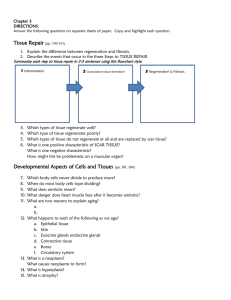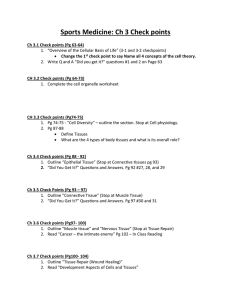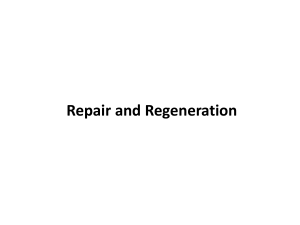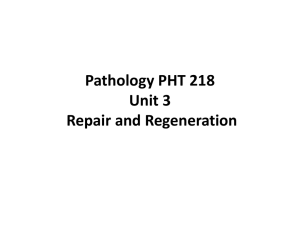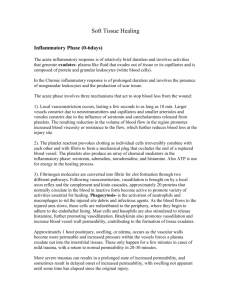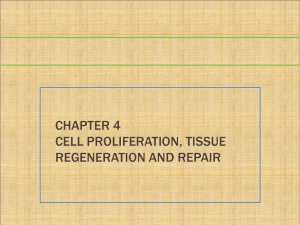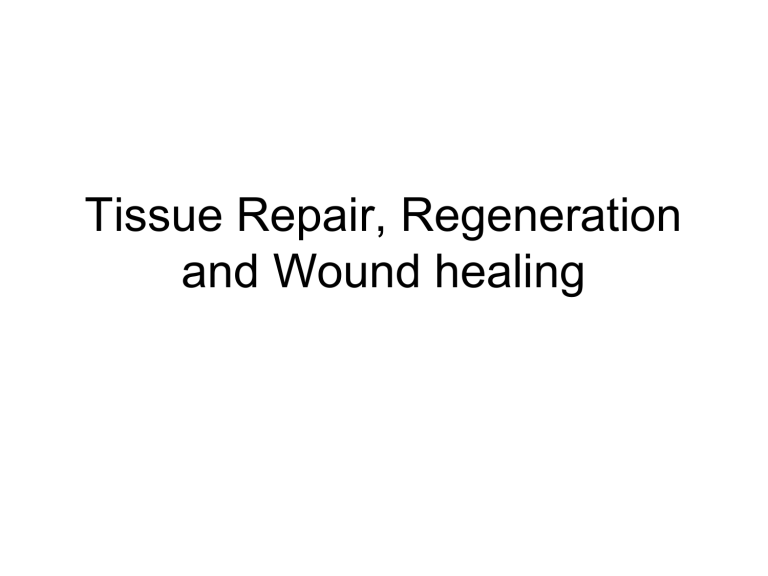
Tissue Repair, Regeneration and Wound healing Tissue Repair • Repair, sometimes called healing, refers to the restoration of tissue architecture and function after an injury. (By convention, the term repair is often used for parenchymal and connective tissues and healing for surface epithelia) Critical to the survival of an organism is the ability to repair the damage toxic insults and inflammation Hence, the inflammatory response to microbes and injured tissues not only serves to eliminate these dangers but also sets into motion the process of repair. • Repair of damaged tissues occurs by two types of reactions: regeneration by proliferation of residual (uninjured) cells and maturation of tissue stem cells • deposition of connective tissue to form a scar. Repair responses following Injury/Inflammation • Regeneration. Some tissues are able to replace the damaged components and essentially return to a normal state; this process is called regeneration. • Regeneration occurs by proliferation of cells • that survive the injury • retain the capacity to proliferate, – in the rapidly dividing epithelia of the skin and intestines, and in some parenchymal organs, notably the liver. – In other cases, tissue stem cells may contribute to the restoration of damaged tissues. – However, mammals have a limited capacity to regenerate damaged tissues and organs, and only some components of most tissues are able to fully restore themselves. • Connective tissue deposition (scar formation). If the injured tissues are incapable of complete restitution, or if the supporting structures of the tissue are severely damaged, repair occurs by the laying down of connective (fibrous) tissue, a process that may result in scar formation. Although the fibrous scar is not normal, it provides enough structural stability that the injured tissue is usually able to function. The term fibrosis is most often used to describe the extensive deposition of collagen that occurs in the lungs, liver, kidney, and other organs as a consequence of chronic inflammation, or in the myocardium after extensive ischemic necrosis (infarction). If fibrosis develops in a tissue space occupied by an inflammatory exudate, it is called organization (as in organizing pneumonia affecting the lung) Cell and Tissue Regeneration • The regeneration of injured cells and tissues involves cell proliferation, which is driven by growth factors and is critically dependent on the integrity of the extracellular matrix, and by the development of mature cells from stem cells. Cell Proliferation • Several cell types proliferate during tissue repair. – include the remnants of the injured tissue (which attempt to restore normal structure), – vascular endothelial cells (to create new vessels that provide the nutrients needed for the repair process), – and fibroblasts (the source of the fibrous tissue that forms the scar to fill defects that cannot be corrected by regeneration). • Labile (continuously dividing) tissues. Cells of these tissues are continuously being lost and replaced by maturation from tissue stem cells and by proliferation of mature cells. • Labile cells include – hematopoietic cells in the bone marrow – the majority of surface epithelia, – such as the stratified squamous epithelia of the skin, oral cavity, vagina, and cervix; the cuboidal epithelia of the ducts draining exocrine organs (e.g., salivary glands, pancreas, biliary tract); the columnar epithelium of the gastrointestinal tract, uterus, and fallopian tubes; and the transitional epithelium of the urinary tract. These tissues can readily regenerate after injury as long as the pool of stem cells is preserved. • Stable tissues. Cells of these tissues are quiescent (in the G0 stage of the cell cycle) and have only minimal proliferative activity in their normal state. • These cells are capable of dividing in response to injury or loss of tissue mass. • Stable cells constitute the parenchyma of most solid tissues, such as liver, kidney, and pancreas. • They also include endothelial cells, fibroblasts, and smooth muscle cells; the proliferation of these cells is particularly important in wound healing. • With the exception of liver, stable tissues have a limited capacity to regenerate after injury. • Permanent tissues. The cells of these tissues are considered to be terminally differentiated and non proliferative in postnatal life. • The majority of neurons and cardiac muscle cells belong to this category. • Thus, injury to the brain or heart is irreversible and results in a scar, because neurons and cardiac myocytes cannot regenerate. • Limited stem cell replication and differentiation occur in some areas of the adult brain, and there is some evidence that heart muscle cells may proliferate after myocardial necrosis. • Nevertheless, whatever proliferative capacity may exist in these tissues, it is insufficient to produce tissue regeneration after injury. • Skeletal muscle is usually classified as a permanent tissue, but satellite cells attached to the endomysial sheath provide some regenerative capacity for muscle. In permanent tissues, repair is typically dominated by scar formation. Mechanisms of Tissue Regeneration • In labile tissues, such as the epithelia of the intestinal tract and skin, injured cells are rapidly replaced by proliferation of residual cells and differentiation of tissue stem cells provided the underlying basement membrane is intact. • The growth factors involved in these processes are not defined. • Loss of blood cells is corrected by proliferation of hematopoietic stem cells in the bone marrow and other tissues, driven by growth factors called colony-stimulating factors (CSFs), which are produced in response to the reduced numbers of blood cells. • Tissue regeneration • • • • can occur in parenchymal organs with stable cell populations, but with the exception of the liver, this is usually a limited process. Pancreas, adrenal, thyroid, and lung have some regenerative capacity. Surgical removal of a kidney elicits in the remaining kidney a compensatory response that consists of both hypertrophy and hyperplasia of proximal duct cells. Mechanisms underlying this response are not understood, but likely involve local production of growth factors and interactions of cells with the ECM. Extraordinary capacity of the liver to regenerate has made it a valuable model for studying this process. Liver Regeneration • Regeneration of the liver occurs by two major mechanisms: • Proliferation of remaining hepatocytes • Repopulation from progenitor cells. • Proliferation of hepatocytes following partial hepatectomy. • In humans, resection of up to 90% of the liver can be corrected by proliferation of the residual hepatocytes. • Hepatocyte proliferation in the regenerating liver is triggered by the combined actions of cytokines and polypeptide growth factors. • In the first, or priming, phase, cytokines such as IL-6 are produced mainly by Kupffer cells and act on hepatocytes to make the parenchymal cells competent to receive and respond to growth factor signals. • In the second, or growth factor, phase, growth factors such as HGF and TGF-α, produced by many cell types, act on primed hepatocytes to stimulate cell metabolism and entry of the cells into the cell cycle. • Because hepatocytes are quiescent cells, it takes them several hours to enter the cell cycle, progress from G0 to G1, and reach the S phase of DNA replication. • Almost all hepatocytes replicate during liver regeneration after partial hepatectomy. The wave of hepatocyte replication is followed by replication of nonparenchymal cells (Kupffer cells, endothelial cells, and stellate cells). • During the phase of hepatocyte replication, more than 70 genes are activated; these include genes encoding transcription factors, cell cycle regulators, regulators of energy metabolism, and many others. • In the final, termination, phase, hepatocytes return to quiescence. • Liver regeneration from progenitor cells. In situations where the proliferative capacity of hepatocytes is impaired, such as after chronic liver injury or inflammation, progenitor cells in the liver contribute to repopulation. • In rodents, these progenitor cells have been called oval cells because of the shape of their nuclei. • Some of these progenitor cells reside in specialized niches called canals of Hering, where bile canaliculi connect with larger bile ducts. Repair by Connective Tissue Deposition • If repair cannot be accomplished by regeneration alone – it occurs by replacement of the injured cells with connective tissue, • leading to the formation of a scar, • or by a combination of regeneration of some residual cells and scar formation. Steps in Scar Formation • • • • • • • Repair by connective tissue deposition consists of sequential processes that follow tissue injury and the inflammatory response. Angiogenesis is the formation of new blood vessels, which supply nutrients and oxygen needed to support the repair process. Newly formed vessels are leaky because of incomplete interendothelial junctions and because VEGF, the growth factor that drives angiogenesis, increases vascular permeability. This leakiness accounts in part for the edema that may persist in healing wounds long after the acute inflammatory response has resolved. Formation of granulation tissue. Migration and proliferation of fibroblasts and deposition of loose connective tissue, together with the vessels and interspersed leukocytes, form granulation tissue. The term granulation tissue derives from its pink, soft, granular gross appearance, such as that seen beneath the scab of a skin wound. Its histologic appearance is characterized by proliferation of fibroblasts and new thin-walled, delicate capillaries (angiogenesis), in a loose extracellular matrix, often with admixed inflammatory cells, mainly macrophages. Granulation tissue progressively invades the site of injury; the amount of granulation tissue that is formed depends on the size of the tissue deficit created by the wound and the intensity of inflammation. Steps in repair by scar formation. Injury to a tissue, such as muscle (which has limited regenerative capacity), first induces inflammation, which clears dead cells and microbes, if any. This is followed by the formation of vascularized granulation tissue and then the deposition of extracellular matrix to form the scar. • Remodeling of connective tissue. Maturation and reorganization of the connective tissue (remodeling) produce the stable fibrous scar. The amount of connective tissue increases in the granulation tissue, eventually resulting in the formation of a scar, which may remodel over time. Granulation tissue showing numerous blood vessels, edema, and a loose extracellular matrix containing occasional inflammatory cells. Collagen is stained blue by the trichrome stain; minimal mature collagen can be seen at this point. B, Trichrome stain of mature scar, showing dense collagen, with only scattered vascular channels. Factors That Influence Tissue Repair • Infection is clinically one of the most important causes of delay in healing; it prolongs inflammation and potentially increases the local tissue injury. • Diabetes is a metabolic disease that compromises tissue repair for many reasons, and is one of the most important systemic causes of abnormal wound healing. • Nutritional status has profound effects on repair; protein deficiency, for example, and particularly vitamin C deficiency, inhibits collagen synthesis and retardshealing. • Glucocorticoids (steroids) have well-documented antiinflammatory effects, and their administration may result in weakness of the scar due to inhibition of TGF-β production and diminished fibrosis. • Mechanical factors such as increased local pressure or torsion may cause wounds to pull apart, or dehisce. • Poor perfusion, due either to arteriosclerosis and diabetes or to obstructed venous drainage (e.g., in varicose veins), also impairs healing. • Foreign bodies such as fragments of steel, glass, or even bone impede healing. • The type and extent of tissue injury affects the subsequent repair. Complete restoration can occur only in tissues composed of stable and labile cells; even then, extensive injury will probably result in incomplete tissue regeneration and at least partial loss of function. Injury to tissues composed of permanent cells must inevitably result in scarring with, at most, attempts at functional compensation by the remaining viable elements. Such is the case with healing of a myocardial infarct. • The location of the injury and the character of the tissue in which the injury occurs are also important. • For example, inflammation arising in tissue spaces (e.g., pleural, peritoneal, synovial cavities) develops extensive exudates. • Subsequent repair may occur by digestion of the exudate, initiated by the proteolytic enzymes of leukocytes and resorption of the liquefied exudate. This is called resolution, and in the absence of cellular necrosis, normal tissue architecture is generally restored. • However, in the setting of larger accumulations, the exudate undergoes organization: granulation tissue grows into the exudate, and a fibrous scar ultimately forms. Selected Clinical Examples of Tissue Repair and Fibrosis • two clinically significant types of repair— the healing of skin wounds (cutaneous wound healing) and • fibrosis in injured parenchymal organs. Healing of Skin Wounds • Process that involves both epithelial regeneration and the formation of connective tissue scar and is thus illustrative of the general principles that apply to healing in all tissues. • Based on the nature and size of the wound, the healing of skin wounds is said to occur by first or second intention. Healing by First Intention • When the injury involves only the epithelial layer, the principal mechanism of repair is epithelial regeneration, also called primary union or healing by first intention. • One of the simplest examples of this type of wound repair is the healing of a clean, uninfected surgical incision approximated by surgical sutures. • Incision causes only focal disruption of epithelial basement membrane continuity and death of relatively few epithelial and connective tissue cells. • The repair consists of three connected processes: inflammation, proliferation of epithelial and other cells, and maturation of the connective tissue scar. • Wounding causes the rapid activation: • coagulation pathways, – which results in the formation of a blood clot on the wound surface. – In addition to entrapped red cells, the clot contains fibrin, fibronectin, and complement proteins. – The clot serves to stop bleeding and acts as a scaffold for migrating cells, which are attracted by growth factors, cytokines, and chemokines released into the area. – Release of VEGF leads to increased vessel permeability and edema. As dehydration occurs at the external surface of the clot, a scab covering the wound is formed. • Within 24 hours, neutrophils are seen at the incision margin, migrating toward the fibrin clot. • They release proteolytic enzymes that begin to clear the debris. • Basal cells at the cut edge of the epidermis begin to show increased mitotic activity. • Within 24 to 48 hours, epithelial cells from both edges have begun to migrate and proliferate along the dermis, depositing basement membrane components as they progress. • The cells meet in the midline beneath the surface scab, yielding a thin but continuous epithelial layer that closes the wound. • By day 3, neutrophils have been largely replaced by macrophages, and granulation tissue progressively invades the incision space. • Macrophages are key cellular constituents of tissue repair, clearing extracellular debris, fibrin, and other foreign material, and promoting angiogenesis and ECM deposition. • Collagen fibers are now evident at the incision margins. • Epithelial cell proliferation continues, forming a covering approaching the normal thickness of the epidermis. • By day 5, neovascularization reaches its peak as granulation tissue fills the incisional space. • These new vessels are leaky, allowing the passage of plasma proteins and fluid into the extravascular space. • Thus, new granulation tissue is often edematous. • Migration of fibroblasts to the site of injury is driven by chemokines, TNF, PDGF, TGF-β, and FGF. • Their subsequent proliferation is triggered by multiple growth factors, including PDGF, EGF, TGF-β, and FGF, and the cytokines IL-1 and TNF. • The fibroblasts produce ECM proteins, and collagen fibrils become more abundant and begin to bridge the incision. • Epidermis recovers its normal thickness as differentiation of surface cells yields a mature epidermal architecture with surface keratinization. • During the second week, there is continued collagen accumulation and fibroblast proliferation. • The leukocyte infiltrate, edema, and increased vascularity are substantially diminished. • The process of “blanching” begins, accomplished by increasing collagen deposition within the incisional scar and the regression of vascular channels. • By the end of the first month, the scar comprises a cellular connective tissue largely devoid of inflammatory cells and covered by an essentially normal epidermis. • However, the dermal appendages destroyed in the line of the incision are permanently lost. • The tensile strength of the wound increases with time. Healing by Second Intention • When cell or tissue loss is more extensive, such as in large wounds, abscesses, ulceration, and ischemic necrosis (infarction) in parenchymal organs, the repair process involves a combination of regeneration and scarring. • In healing of skin wounds by second intention, also known as healing by secondary union and, the inflammatory reaction is more intense, there is development of abundant granulation tissue, accumulation of ECM and formation of a large scar, and wound contraction by the action of myofibroblasts. • In wounds causing large tissue deficits, the fibrin clot is larger, and there is more exudate and necrotic debris in the wounded area. • Inflammation is more intense because large tissue defects have a greater volume of necrotic debris, exudate, and fibrin that must be removed. • Consequently, large defects have a greater potential for secondary, inflammation-mediated, injury. • Much larger amounts of granulation tissue are formed. • Larger defects require a greater volume of granulation tissue to fill in the gaps and provide the underlying framework for the regrowth of tissue epithelium. • A greater volume of granulation tissue generally results in a greater mass of scar tissue. • At first a provisional matrix containing fibrin, plasma fibronectin, and type III collagen is formed. • About 2 weeks this is replaced by a matrix composed primarily of type I collagen. • Ultimately, the original granulation tissue scaffold is converted into a pale, avascular scar, composed of spindle-shaped fibroblasts, dense collagen, fragments of elastic tissue, and other ECM components. The dermal appendages that have been destroyed in the line of the incision are permanently lost. • The epidermis recovers its normal thickness and architecture. By the end of the first month, the scar is made up of acellular connective tissue devoid of inflammatory infiltrate, covered by intact epidermis. • Wound contraction generally occurs in large surface wounds. • Contraction helps to close the wound by decreasing the gap between its dermal edges and by reducing the wound surface area. • Initial steps of wound contraction involve the formation, at the edge of the wound, of a network of myofibroblasts, which are modified fibroblasts exhibiting many of the ultrastructural and functional features of contractile smooth muscle cells. • Within 6 weeks, large skin defects may be reduced to 5% to 10% of their original size, largely by contraction. Healing of skin ulcers. A, Pressure ulcer of the skin, commonly found in diabetic patients. The histologic slides show a skin ulcer with a large gap between the edges of the lesion (B), a thin layer of epidermal reepithelialization and extensive granulation tissue formation in the dermis (C), and continuing reepithelialization of the epidermis and wound contraction (D). (Courtesy Z. Argenyi, MD, University of Washington, Seattle, Wash.)
